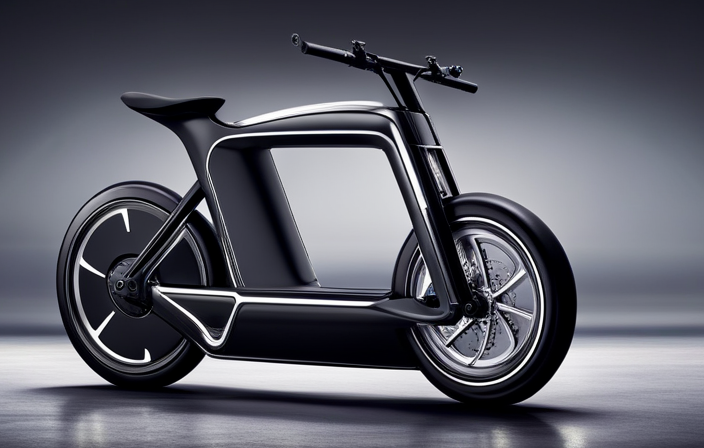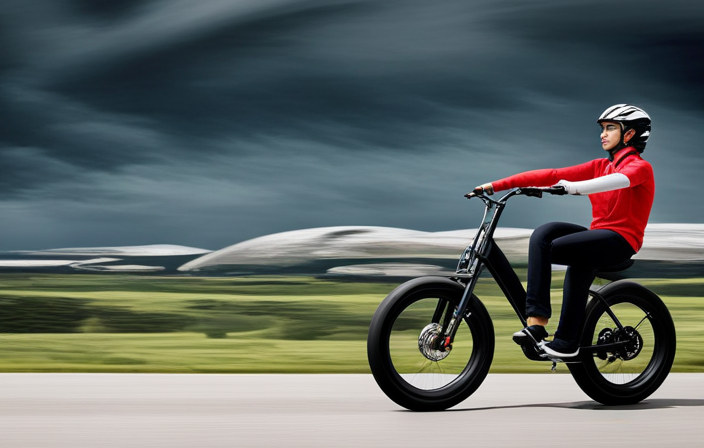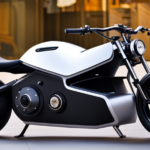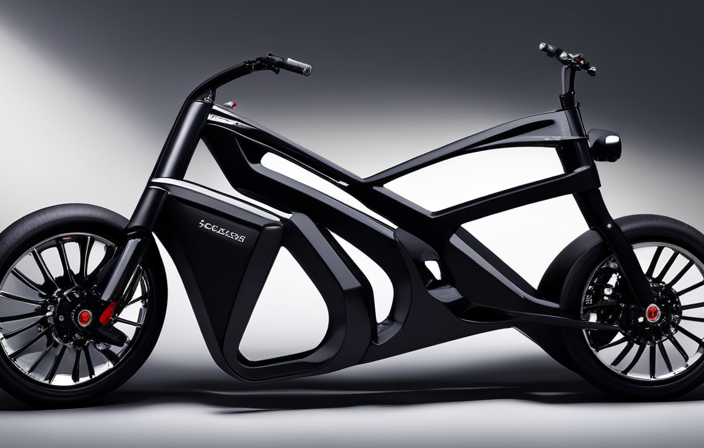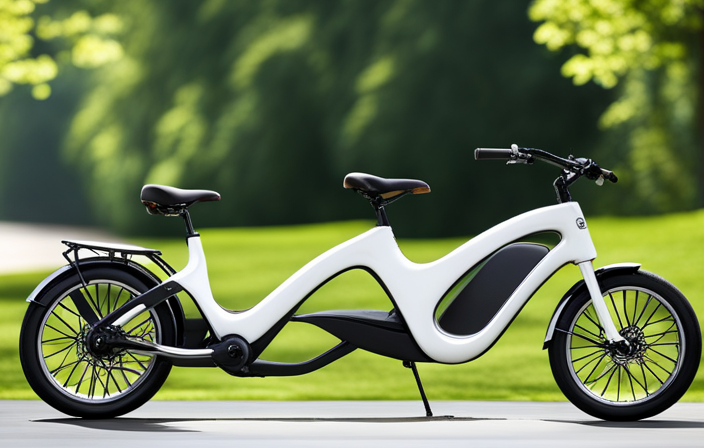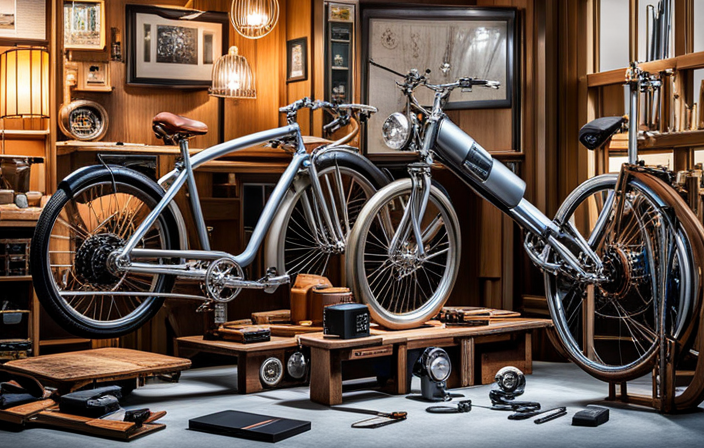Are you ready to experience the exhilaration of riding a bike like never before? Prepare to be amazed by the incredible power and efficiency of electric bikes.
These cutting-edge machines combine the best of both worlds, blending the simplicity and health benefits of traditional cycling with the speed and ease of a motorized vehicle. Imagine effortlessly zooming up hills, gliding along with the wind in your hair.
In this article, I will unravel the mysteries behind how electric bikes work, uncovering the technology that propels this revolutionary mode of transportation forward.
Get ready to be electrified!
Key Takeaways
- Electric bikes combine traditional cycling with motorized assistance
- Lithium-ion batteries are more compact and lighter, ideal for electric bikes
- Motor efficiency determines the power output and battery usage
- Pedal assist provides a boost to the rider’s pedaling power
Introduction to Electric Bikes
If you’re curious about electric bikes, you’ll be amazed at how they work. Electric bike technology has come a long way, and these modern marvels offer numerous advantages over traditional bicycles.
Electric bikes, also known as e-bikes, are equipped with an electric motor that assists the rider’s pedaling efforts. This motor is powered by a rechargeable battery, which provides the necessary energy to propel the bike forward. The motor’s assistance can be adjusted to different levels, allowing riders to choose the amount of assistance they need. This makes electric bikes perfect for tackling hilly terrains or for those who may struggle with physical limitations.
The advantages of electric bikes are vast, including increased speed, extended range, and reduced effort required for pedaling. With the battery powering the ride, electric bikes offer a revolutionary way to experience cycling.
The Battery: Powering the Ride
When it comes to electric bike batteries, there are two main types to consider: lithium-ion and lead-acid batteries.
Lithium-ion batteries have become the more popular choice due to their higher energy density, longer lifespan, and lighter weight.
In contrast, lead-acid batteries are cheaper but are heavier and have a shorter lifespan.
Another important consideration is battery capacity, which determines the range of the electric bike.
A higher battery capacity means a longer range, allowing for more extended rides without the need for recharging.
Lithium-ion vs. lead-acid batteries
To determine which battery is best for your electric bike, you should consider the differences between lithium-ion and lead-acid batteries.
Lithium-ion batteries have several advantages over lead-acid batteries. Firstly, they are lighter and more compact, making them ideal for electric bikes where weight and space are crucial factors. Secondly, lithium-ion batteries have a higher energy density, which means they can store more energy in a smaller volume. This results in longer ride times and increased range for your electric bike.
However, lithium-ion batteries also have some disadvantages. They are more expensive than lead-acid batteries and can be more sensitive to temperature changes.
Lead-acid batteries, on the other hand, are less expensive and have a longer lifespan. They are also more resistant to extreme temperatures.
Considering these factors, it is clear that lithium-ion batteries offer significant advantages for electric bikes.
Moving on to battery capacity and range, let’s take a closer look at how these factors impact your ride.
Battery capacity and range
Considering the battery capacity and range is crucial when choosing the best battery for your electric bike. The battery capacity refers to the amount of energy the battery can store, while the range determines how far you can go on a single charge. To help you understand the importance of these factors, let me present a comparison between lithium-ion and lead-acid batteries in terms of battery life and charging time:
| Battery Type | Battery Life | Charging Time |
|---|---|---|
| Lithium-ion | Longer | Shorter |
| Lead-acid | Shorter | Longer |
As you can see, lithium-ion batteries have a longer battery life and shorter charging time compared to lead-acid batteries. This means that with a lithium-ion battery, you can enjoy longer rides and spend less time waiting for your battery to charge. Now, let’s move on to the next section about the motor: propelling the bike.
The Motor: Propelling the Bike
The motor is what propels your electric bike forward. It is responsible for converting electrical energy from the battery into mechanical energy, which turns the wheels and propels the bike. Understanding the motor efficiency and power output is essential when considering an electric bike. Here are three key points to consider:
-
Motor Efficiency: This refers to how well the motor converts electrical energy into mechanical energy. A higher efficiency motor will provide more power to the wheels while using less energy from the battery, resulting in a longer range.
-
Motor Power Output: This determines how much power the motor can deliver to propel the bike. It is usually measured in watts. A higher power output means faster acceleration and better performance, especially when climbing hills or carrying heavy loads.
-
Battery-Motor Compatibility: It is crucial to ensure that the motor power output matches the capacity and capabilities of the battery. A mismatch may result in reduced performance or even damage to the components.
Considering these factors will help you choose the right motor for your electric bike. With the motor efficiently converting energy and delivering the necessary power, the next section will explore how pedal assist further enhances your riding experience.
Pedal Assist: Enhancing the Ride
As we discussed in the previous section, the motor is responsible for propelling the electric bike. But what if I told you that there is another component that can enhance the ride even further? Enter pedal assist, a feature that revolutionizes the way we ride electric bikes.
Pedal assist is a technology that works in conjunction with the motor to provide a boost to the rider’s pedaling power. It uses a sensor to detect the rider’s pedaling cadence and force, and then sends a signal to the motor to provide additional power accordingly. This not only enhances the efficiency of the electric bike but also improves its overall performance.
By incorporating pedal assist, riders can effortlessly tackle inclines, ride longer distances, and enjoy a smoother and more enjoyable ride. It truly takes the electric bike experience to the next level.
Now, let’s dive into the next section where we will explore the exciting world of throttle control: on-demand power.
Throttle Control: On-demand Power
Throttle control is a crucial feature in electric bikes that allows riders to have on-demand power at their fingertips. By simply twisting the throttle, I can easily control the speed and acceleration of the bike. This feature provides a seamless and effortless riding experience, especially when navigating through hills or when I need an extra boost of power.
Additionally, throttle control offers the benefit of immediate response, allowing me to quickly accelerate or decelerate without having to rely solely on pedal power.
How throttle control works
To control the speed of an electric bike, you can use the throttle. The throttle is a control mechanism that allows the rider to increase or decrease the power output of the electric motor.
The throttle sensitivity refers to how quickly the motor responds to the input from the rider. A highly sensitive throttle will provide instant power, while a less sensitive throttle may have a slight delay in response time.
The throttle response time is the time it takes for the motor to reach its maximum power output after the throttle is applied. This can vary depending on the specific electric bike model and the power of the motor. Having a quick throttle response time can provide a more dynamic and responsive riding experience.
Transitioning into the next section, the benefits of throttle control include enhanced control over the bike’s speed and acceleration.
Benefits of throttle control
One of the advantages of using throttle control is that it provides the rider with increased control over their speed and acceleration. With throttle control, the rider can easily adjust the power output of the electric bike, allowing for precise speed regulation.
By simply twisting the throttle, the rider can increase or decrease the amount of power being delivered to the motor, which directly affects the bike’s speed. This level of control is especially useful in situations where the rider needs to navigate through traffic or make quick maneuvers.
Additionally, throttle control allows the rider to maintain a consistent speed without the need for constant pedaling. This can be particularly beneficial on longer rides or when facing uphill terrain. By effectively managing the power control and speed regulation, riders can experience a smoother and more enjoyable ride.
Transitioning into the subsequent section about ‘electric bike components: putting it all together,’ we can now explore how all the different parts work in harmony to create an efficient electric bike system.
Electric Bike Components: Putting it All Together
When it comes to electric bike components, there are three key aspects that play a crucial role in providing a seamless riding experience:
-
The frame and suspension determine the overall stability and comfort of the bike, ensuring a smooth ride even on rough terrains.
-
The brakes and gears are essential for controlling the speed and navigating various inclines.
-
The display and controls allow for easy monitoring of battery life, speed, and other important metrics.
Frame and suspension
You can feel the difference in the ride quality of an electric bike with a well-designed frame and suspension. The frame materials used in electric bikes can vary, but common options include aluminum, steel, and carbon fiber.
Aluminum frames are lightweight, durable, and affordable, making them a popular choice. Steel frames offer a smooth ride and excellent strength, although they can be heavier. Carbon fiber frames are the lightest and most expensive, providing a stiff and responsive ride.
When it comes to suspension types, electric bikes may have either front suspension, rear suspension, or both. Front suspension forks absorb shocks and bumps from the front wheel, while rear suspension systems do the same for the rear wheel.
This combination of frame and suspension ensures a comfortable and smooth ride, allowing riders to tackle various terrains with ease.
Now, let’s transition to the next section about brakes and gears.
Brakes and gears
The braking system and gear mechanism are essential components of an electric bicycle. The brakes on an electric bike are typically disc brakes, which provide reliable stopping power in various weather conditions. Regular maintenance is important to ensure optimal performance of the brakes, including checking the brake pads for wear and adjusting the brake calipers if necessary.
When it comes to gear shifting, electric bikes usually have a derailleur system that allows for smooth and efficient gear changes. Proper gear shifting techniques involve anticipating the terrain and adjusting the gears accordingly to maintain a comfortable cadence. It is important to avoid shifting gears under heavy load to prevent damage to the drivetrain.
Transitioning into the next section about ‘display and controls,’ understanding the braking system and gear mechanism is crucial for effectively operating an electric bicycle.
Display and controls
Moving on from the discussion of brakes and gears, let’s now delve into the fascinating world of the display and controls on an electric bike. The display serves as the central hub of information, providing real-time data on speed, battery life, distance traveled, and more. But it doesn’t stop there. With display customization, riders can personalize their biking experience by choosing what information is displayed and how it is presented. Moreover, the controls play a crucial role in ensuring a seamless riding experience. From adjusting power levels to activating the motor, control responsiveness is key. With just a touch of a button or a twist of a dial, riders can effortlessly navigate through various settings. Now, let’s explore the next topic of charging and maintenance, where we will discover the essential steps to keep the bike running smoothly.
Charging and Maintenance: Keeping the Bike Running
When it comes to keeping my electric bike running smoothly, there are two key tasks that I need to stay on top of: charging the battery and performing routine maintenance.
Charging the battery is crucial to ensure that I have enough power to go the distance. I make sure to plug it in after every ride and let it fully charge before hitting the road again.
As for routine maintenance, I regularly check the tire pressure, tighten any loose bolts, and clean the chain to keep everything in optimal working condition.
By staying on top of these tasks, I can enjoy a reliable and efficient ride every time.
Charging the battery
To charge the battery on your electric bike, simply plug it into a power outlet and let it charge overnight. The charging time may vary depending on the battery capacity and the charger’s output. It is important to note that the battery life of an electric bike can be affected by the way it is charged. Overcharging or undercharging can shorten the battery’s lifespan. To ensure optimal battery life, it is recommended to use the charger provided by the manufacturer and avoid using fast chargers that may overheat the battery. Additionally, routine maintenance tasks such as cleaning the battery terminals and checking for any signs of damage should be performed regularly to keep the battery in good condition. By following these charging and maintenance guidelines, you can ensure that your electric bike stays in peak performance for years to come.
Routine maintenance tasks
After ensuring that the battery is fully charged, it is important to perform routine maintenance tasks to keep your electric bike in optimal condition.
Regular cleaning of the bike is essential to remove dirt, dust, and grime that can accumulate and affect its performance. Use a mild detergent and a soft cloth or sponge to gently clean the frame, wheels, and other components. Pay special attention to the chain, as it can easily accumulate dirt and debris.
Lubricate the chain regularly to ensure smooth and efficient operation.
In addition to cleaning, it is also important to troubleshoot common issues that may arise with your electric bike. This may include checking for loose or damaged components, adjusting brakes and gears, and inspecting the tires for any signs of wear or punctures.
By regularly performing these maintenance tasks, you can ensure that your electric bike is always ready for a smooth and enjoyable ride.
Now, let’s move on to the next section about safety and regulations when riding an electric bike.
Safety and Regulations: Riding an Electric Bike
Although there are safety and regulations involved, riding an electric bike is a fun and convenient way to travel.
When it comes to electric bike safety, it is crucial to wear a helmet to protect your head in case of accidents. Additionally, follow traffic rules and signals just like you would on a regular bicycle. It is important to be visible to other road users, so consider adding reflective gear to your clothing or bike.
Electric bike regulations vary from country to country, so make sure to familiarize yourself with the specific rules in your area. This may include restrictions on speed, age limits, or the need for a license or registration. Understanding and adhering to these regulations will help ensure a safe and legal riding experience.
Moving on to the benefits of electric bikes, they provide a cost-effective and eco-friendly transportation option.
Benefits of Electric Bikes
One of the advantages of riding an electric bike is its cost-effectiveness. Electric bikes are much cheaper to run compared to cars or motorcycles. They require less maintenance, as they have fewer moving parts and don’t need regular oil changes. Additionally, the cost of electricity to charge the battery is significantly lower than the cost of gasoline.
Another advantage is the eco-friendly features of electric bikes. They produce zero emissions, helping to reduce air pollution and minimize our carbon footprint. Electric bikes also contribute to a quieter and more peaceful environment, as they produce less noise compared to traditional vehicles. These benefits make electric bikes a sustainable and environmentally-friendly mode of transportation.
Transitioning into the next section, understanding these advantages can help in choosing the right electric bike for you.
Choosing the Right Electric Bike for You
To choose the right electric bike for you, consider your riding preferences and needs. Understanding the options and features of electric bikes is crucial in making an informed decision. Here are some factors to consider when buying an electric bike:
-
Motor power: Determine the motor power you require based on the terrain and the level of assistance you desire. Higher wattage motors provide more power and better performance.
-
Battery capacity: Consider the battery capacity and range offered by different electric bikes. A larger capacity battery will allow for longer rides without needing to recharge.
-
Frame type: Choose a frame type that suits your riding style. There are options like step-through frames for easy mounting/dismounting and traditional diamond frames for a sportier feel.
-
Additional features: Look for features like suspension, gears, and brakes that align with your riding preferences.
Considering these factors will help you find the perfect electric bike for your needs. In the next section, we will discuss riding tips and techniques to enhance your electric bike experience.
Riding Tips and Techniques
When riding your electric bike, it’s important to learn and practice various tips and techniques to enhance your overall experience. Mastering proper riding techniques and bike handling will not only make your rides safer but also more enjoyable.
One of the key techniques to focus on is maintaining a stable and balanced position on the bike. Keep your body relaxed, grip the handlebars firmly, and distribute your weight evenly. When turning, lean your body and the bike into the direction of the turn, while also counter-steering to maintain control.
Additionally, make sure to maintain a safe following distance from other vehicles and always be aware of your surroundings. By practicing these riding techniques, you will have more control over your electric bike and be able to navigate various terrains with ease.
Transitioning to the subsequent section about maintenance tips for electric bikes, remember that proper bike handling is crucial for ensuring the longevity and performance of your electric bike.
Maintenance Tips for Electric Bikes
To maintain your electric bike, it’s important to regularly clean and lubricate the chain to keep it running smoothly. Electric bike maintenance is crucial for prolonging battery life and ensuring optimal performance.
Start by wiping down the chain with a clean rag to remove any dirt or debris. Then, apply a bicycle-specific chain lubricant, making sure to cover each link thoroughly. This will reduce friction and prevent premature wear.
Additionally, check the tire pressure regularly and inflate as needed to ensure a smooth ride. Keep an eye on the brake pads and replace them if they become worn down.
Finally, store your electric bike in a cool, dry place when not in use to protect the battery.
By following these maintenance tips, you can keep your electric bike in top condition and enjoy many miles of trouble-free riding.
As we move into the next section about electric bike accessories, let’s explore how to enhance your riding experience even further.
Electric Bike Accessories
One way to enhance your riding experience is by adding accessories to your electric bike. Electric bike accessories not only provide added convenience and comfort, but they can also help you maintain your bike in optimal condition.
Some essential accessories to consider include a bike computer, which can track your speed, distance, and battery life, allowing you to monitor your ride more effectively. A sturdy bike lock is also a must-have accessory to ensure the security of your electric bike when you need to park it.
Additionally, investing in a good quality bike pump and tire repair kit will help you maintain proper tire pressure and fix any punctures on the go.
These accessories, along with regular maintenance tips, will ensure that your electric bike remains in great shape for years to come.
As we look to the future of transportation, electric bikes are poised to revolutionize urban commuting and reduce carbon emissions.
Electric Bikes and the Future of Transportation
Improve your daily commute and reduce your carbon footprint with the future of transportation – electric bikes. As technology continues to advance, electric bikes are becoming more efficient, powerful, and affordable.
The future of electric bikes holds exciting advancements, such as improved battery technology, lighter frames, and enhanced motor performance. These advancements will result in longer battery life, faster speeds, and increased range, making electric bikes a viable option for longer journeys.
Not only are electric bikes environmentally friendly, but they also provide a convenient and cost-effective mode of transportation. With zero emissions and the ability to navigate through traffic easily, electric bikes have a significant positive impact on the environment and reduce congestion on roads.
Embracing the electric bike revolution is a logical step in creating a sustainable and efficient transportation system for the future.
Conclusion: Embracing the Electric Bike Revolution
Get ready to embrace the electric bike revolution and experience a greener, more efficient way of commuting. Electric bike adoption is on the rise, and it’s not hard to see why. Not only do electric bikes offer a fun and convenient mode of transportation, but they also have a significant impact on the environment. By replacing traditional gas-powered vehicles with electric bikes, we can reduce harmful emissions and make our cities cleaner and healthier places to live.
To understand the environmental impact of electric bikes, let’s take a closer look at the numbers. According to a recent study, a typical electric bike produces only about 22 grams of CO2 emissions per kilometer, compared to a whopping 271 grams emitted by a typical car. Furthermore, electric bikes are significantly more fuel-efficient, with an average energy consumption of just 0.1 kWh per kilometer, compared to 1.3 kWh for cars.
By embracing the electric bike revolution, we can make a positive change for the environment and our own well-being. So why wait? Let’s hop on our electric bikes and start enjoying a cleaner, greener commute.
Frequently Asked Questions
Are electric bikes legal to ride on public roads?
Yes, electric bikes are legal to ride on public roads, but there are specific safety regulations that must be followed. Electric bikes offer numerous benefits for commuting, such as increased speed and reduced effort.
How fast can an electric bike go?
Electric bikes can reach speeds up to 20 mph, but various factors influence their speed limits. These factors include terrain, rider weight, battery power, and motor capacity.
Can I ride an electric bike in the rain?
Yes, you can ride an electric bike in the rain. Riding in wet weather requires extra caution, but electric bikes have several benefits in rain such as improved traction, reduced slipping, and the ability to maintain a steady speed.
How long does it take to charge an electric bike battery?
Charging time for an electric bike battery depends on the battery capacity and the charger’s power output. Generally, it takes around 4-6 hours to fully charge the battery. Battery life can vary depending on usage and maintenance.
Are there any maintenance requirements specific to electric bikes?
Maintaining an electric bike is crucial for smooth rides. Follow this maintenance checklist to avoid common issues. Regularly check tire pressure, clean the chain, inspect brakes, and keep the battery charged.
Conclusion
In conclusion, the electric bike revolution is a game-changer in the world of transportation. Embracing this cutting-edge technology allows us to effortlessly glide through our daily commutes while reducing our carbon footprint.
With the battery as our trusty companion, providing the power needed, and the motor propelling us forward, we can conquer any terrain with ease. Pedal assist and throttle control enhance our riding experience, giving us the freedom to choose our level of exertion.
So let’s jump on board, accessorize our electric bikes, and ride towards a cleaner and greener future.
